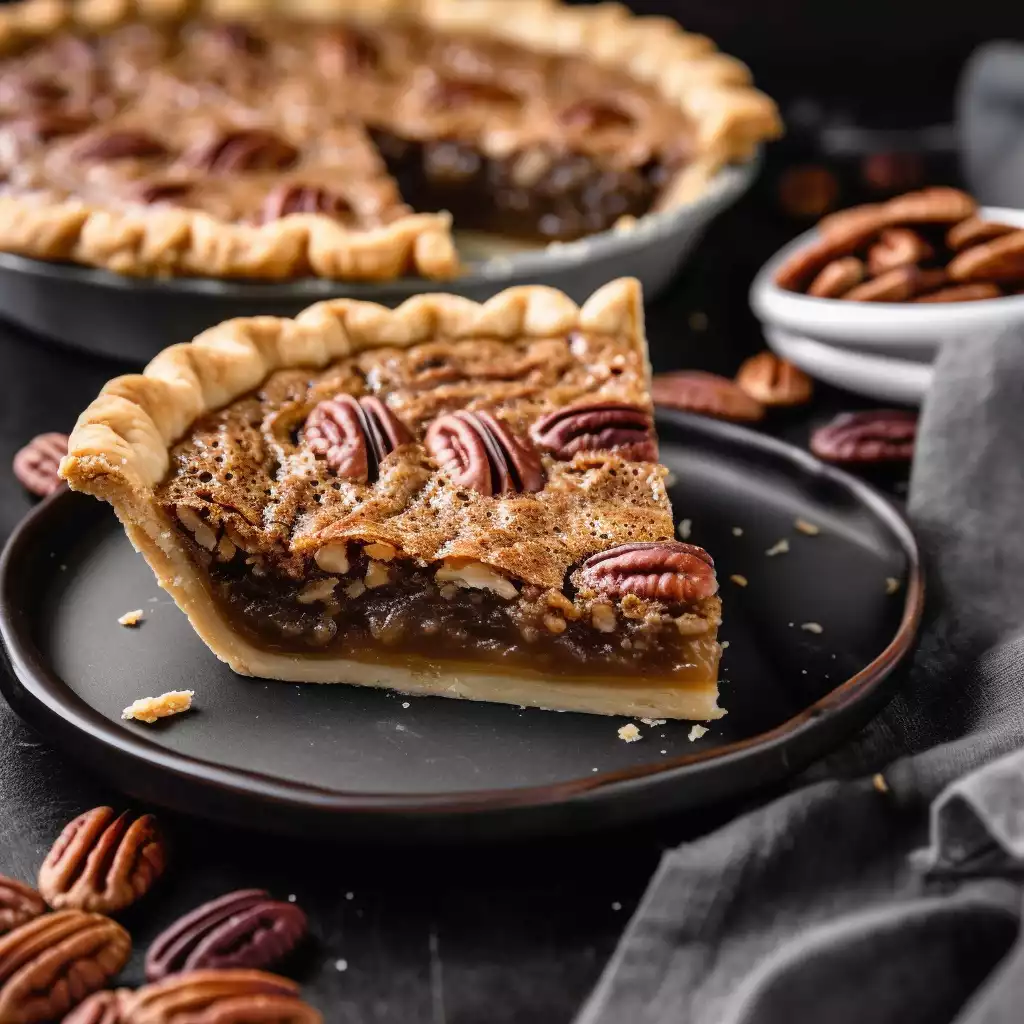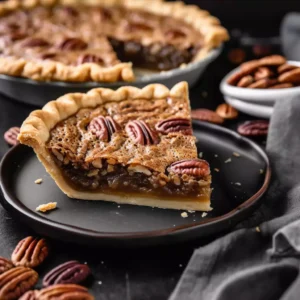
Pecan pie, a dessert steeped in tradition, holds a special place in the world of sweets. This delightful pastry has its roots in the Southern United States, emerging as a regional specialty that quickly captured the hearts and palates of people across the country.
The history of pecan pie is somewhat murky, with various stories and myths surrounding its origin. Some believe it was invented by French settlers in New Orleans, while others attribute its creation to the early American settlers who were introduced to pecans by Native Americans.
The beauty of pecan pie lies in its simplicity and the harmonious balance of flavours.
Although considered a classic dish, it’s surprisingly not too tricky to master, making it a great choice for beginners looking to explore the art of pie-making. Its straightforward preparation process, coupled with common, easily available ingredients, adds to its appeal among home bakers.
Pecan pie also allows for a delightful array of variations, catering to different tastes and preferences. Some bakers enjoy adding chocolate or bourbon to the filling for a richer, more complex flavour. Others might incorporate orange zest or switch out the golden syrup for maple syrup, lending the pie a distinct, regional touch.
At its core, pecan pie consists of a buttery, flaky pastry crust, filled with a gooey mixture of pecans, syrup, sugar, butter, eggs, and a hint of vanilla. The pecans float to the top during baking, creating a crisp top layer, while the filling underneath remains lusciously sweet and slightly chewy.
The contrast of textures, from the crunchy pecans to the tender crust, makes every bite a delightful experience.
For those who have never tried making pecan pie, the process is rewarding and less daunting than it might seem. The key to a successful pecan pie lies in the quality of the ingredients, especially the pecans, which should be fresh and of good quality for the best flavour. Also, giving the pie enough time to set after baking is crucial; it allows the flavours to meld together beautifully.
Whether you’re a novice baker or an experienced one, this pie is sure to add warmth and sweetness to any gathering. Now, let’s delve into the specific ingredients used and why they’re chosen for this beloved recipe.
Extra Tips: Chill your pie crust dough before rolling it out. This helps prevent shrinkage during baking and ensures a flakier crust.
Pecan pie, with its rich flavours and delightful textures, owes much to the careful selection of ingredients. Each component plays a unique role in crafting this classic dessert. Let’s explore these ingredients and understand their significance in the recipe.
Plain Flour: The starting point for our pie crust, plain flour provides the structure. It’s essential for achieving that perfect balance between flakiness and firmness in the crust. If you need an alternative, gluten-free flour blends can work well, though they may alter the texture slightly. In this recipe, plain flour helps to form a stable base that holds up the rich, syrupy filling without getting soggy.
Unsalted Butter: Cold and cubed unsalted butter is key for a flaky pie crust. It creates those little pockets of steam as the pie bakes, leading to a light and airy texture.
If you don’t have unsalted butter, salted butter can be used, but you’ll need to adjust the added salt accordingly. The butter also adds a rich, creamy flavour, complementing the sweetness of the filling.
Salt: A touch of salt in the crust enhances the overall flavour of the pie. It balances the sweetness and brings out the buttery notes of the crust. In the absence of regular salt, a pinch of sea salt can be a good alternative.
Egg Yolk and Cold Water: These ingredients help to bind the flour and butter together, creating a dough that’s manageable and not too crumbly. The yolk adds richness to the crust, while the cold water provides the necessary moisture to bring the dough together.
Pecan Halves: The star ingredient, pecans, give the pie its distinctive texture and nutty flavour. They rise to the top during baking, creating a crunchy layer. Walnuts can be a substitute if pecans are unavailable. Pecans contribute not just to the taste but also to the iconic appearance of the pie.
Golden Syrup: This imparts a unique, caramel-like flavour to the filling, setting pecan pie apart from other desserts. An alternative could be corn syrup or honey, though the flavour profile will change. Golden syrup also adds to the gooey texture of the filling.
Light Brown Sugar: Brown sugar adds a deep, molasses-like sweetness, complementing the pecans and golden syrup. If needed, white sugar mixed with a bit of molasses can be a substitute. It contributes to the rich colour and depth of flavour in the filling.
Melted Unsalted Butter: In the filling, it adds richness and helps to create a smooth, cohesive mixture. If you’re out of unsalted butter, salted butter can be used with an adjustment in the added salt.
Large Eggs: They act as a binder in the filling, holding all the ingredients together and providing a custard-like consistency. As an alternative, some egg replacement products can be used for those with egg allergies.
Vanilla Extract: A dash of vanilla enhances the overall flavour profile, adding a subtle depth and warmth to the pie. Almond extract can be a substitute, offering a different but equally pleasant taste.
A Pinch of Salt: Just like in the crust, salt in the filling balances the sweetness and brings out the individual flavours of the other ingredients. In pecan pie, each ingredient has its role, contributing to the overall harmony of flavours and textures. Now, let’s look at the FAQ section to answer some common questions about making this delightful dessert.
Expert Tip: For a well-set filling, let the pie cool completely before slicing. This patience rewards you with perfect slices and enhanced flavours.
Absolutely! If you’re short on time or prefer convenience, a store-bought pie crust is a fine alternative. Just make sure it’s uncooked and fits a 9-inch tart tin. Remember, the texture and taste might slightly differ from homemade crust, but it will still be delicious.
Pecan pie is done when the filling sets and the crust turns golden brown. A good indicator is a slight jiggle in the middle of the pie; if it shakes like jelly but isn’t liquid, it’s ready. Overbaking can lead to a dry filling, so keep an eye on it as it nears the 30-minute mark.
Yes, pecan pie can be made in advance. It actually tastes better when allowed to rest. Once cooled, cover it and store it in the refrigerator for up to 4 days. You can serve it cold or bring it to room temperature before serving.
Leftover pecan pie should be covered and stored in the refrigerator. It keeps well for up to 4 days. To refresh, you can warm it in the oven at a low temperature for a few minutes.
Certainly! Pecan pie freezes beautifully. Cool the pie completely, wrap it tightly in plastic wrap and then in foil, and freeze for up to 2 months. Thaw it overnight in the refrigerator and bring it to room temperature or gently warm it in the oven before serving.
For a vegan version, you can substitute the butter with plant-based alternatives, use egg replacers for the eggs, and ensure your syrup is vegan-friendly. The crust can be made with vegan butter and the filling with a combination of corn syrup and flax eggs.
Absolutely! Feel free to experiment by adding chocolate chips, bourbon, or even orange zest to the filling. These additions can give your pecan pie a unique twist.
Expert Tip: To avoid a burnt crust or uneven cooking, place a pie shield or foil around the edges of the pie during the last 15 minutes of baking.
Here are some more recipes for you to enjoy! If you my recipes don’t forget to rate and leave a comment.
If you have any recipe suggestions, please do not hesitate to ask me. A great way to stay in contact with me is through Instagram, Facebook, Twitter and YouTube. Don’t forget to tag me @CookwithNabeela in your recipe photos!

Subscribe now to receive my latest recipes directly in your inbox. Stay up-to-date and never miss out!
Add your first comment to this post